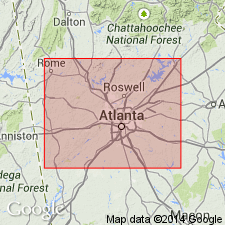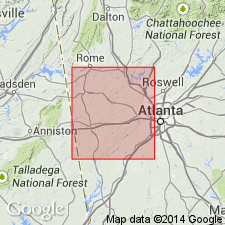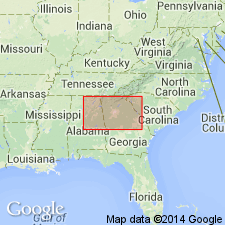
- Usage in publication:
-
- Univeter Formation
- Modifications:
-
- Named
- Dominant lithology:
-
- Amphibolite
- Schist
- Gneiss
- AAPG geologic province:
-
- Piedmont-Blue Ridge province
Summary:
The Univeter Formation of the New Georgia Group is here named in northwest GA. It contains the Lost Mountain Amphibolite Member which forms two limbs of a fold and the intervening Rose Creek Schist Member. The Univeter is composed of amphibolite, hornblende gneiss, garnet-chlorite schist, and thin banded iron formation associated with precious metal deposits. On the southeast the Univeter is in fault contact with the Sandy Springs Group. Age is Late Proterozoic and (or) early Paleozoic.
Source: GNU records (USGS DDS-6; Reston GNULEX).

- Usage in publication:
-
- Univeter Formation
- Modifications:
-
- Revised
- Reference
- AAPG geologic province:
-
- Piedmont-Blue Ridge province
Summary:
Author does not accept thrust sheet stratigraphy proposed by Higgins and others (1986). He adopts the nomenclature of McConnell and Abrams (1984) with minor modifications. Univeter Formation is retained for use in this report and is interpreted as uppermost unit of New Georgia Group. Contact with the underlying Canton Formation northeast of the study area and in the South Canton quad. is conformable. Southwest of the South Canton area, the Univeter is in conformable contact with rocks of the Kellogg Creek Mafic Complex. McConnel and Abrams interpreted these as fault contacts. Lost Mountain Amphibolite Member is here changed to Lost Mountain Member as the unit contains lithologies other than amphibolite. The Rose Creek Schist Member is retained unchanged. Univeter can be mapped within the study area from eastern Paulding Co. northeastward to central Cherokee Co. Has also been mapped northeast of the study area to the Lake Burton area in Habersham Co. Two reference localities are designated along Holly Road and the Little River on the South Canton 7.5-min. quad.
Source: GNU records (USGS DDS-6; Reston GNULEX).

- Usage in publication:
-
- Univeter Formation†
- Modifications:
-
- Abandoned
- AAPG geologic province:
-
- Piedmont-Blue Ridge province
Summary:
The Univeter Formation of McConnell and Abrams (1984), and its Lost Mountain Amphibolite and Rose Creek Schist Members are here abandoned. Recent mapping has shown that these units are parts of the Powers Ferry Formation of the Sandy Springs Group, the Ropes Creek Metabasalt, and the Zebulon Formation.
Source: GNU records (USGS DDS-6; Reston GNULEX).
For more information, please contact Nancy Stamm, Geologic Names Committee Secretary.
Asterisk (*) indicates published by U.S. Geological Survey authors.
"No current usage" (†) implies that a name has been abandoned or has fallen into disuse. Former usage and, if known, replacement name given in parentheses ( ).
Slash (/) indicates name conflicts with nomenclatural guidelines (CSN, 1933; ACSN, 1961, 1970; NACSN, 1983, 2005, 2021). May be explained within brackets ([ ]).

